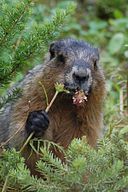The Wrack
The Wrack is the Wells Reserve blog.
The Wrack is the Wells Reserve blog.
Posted 2013, updated 2022
 We in Maine don't have much call for marking Groundhog Day. Our groundhogs (woodchucks, if you prefer) are wholly unlikely to poke a nose up at this time of year, even if there's scant snow around their burrows. No, unlike their Punxsutawney pals, they're lying low a while longer before checking for any shadows.
We in Maine don't have much call for marking Groundhog Day. Our groundhogs (woodchucks, if you prefer) are wholly unlikely to poke a nose up at this time of year, even if there's scant snow around their burrows. No, unlike their Punxsutawney pals, they're lying low a while longer before checking for any shadows.
That's a good thing, too, at least for those who are after a swift end to winter: We've got plenty of sunshine on the Wells landscape this morning, ideal for shaping well defined groundhog shadows. Regardless of any rodent's folksy forecast, though, it's a good bet every February 2nd that we can plan on (at least) six more weeks of seasonally appropriate weather in this town.

When the time comes for Maine's Marmota monax to make an appearance, I know one person who'll be paying close attention: Dr. Christine Maher from the University of Southern Maine.
Back in November, Dr. Maher came to Mather Auditorium to present a Lunch n Learn on one of her favorite topics — yep, groundhogs. She's been studying them since 1998 and has lots to tell about the animals.
Working at Gilsland Farm in Falmouth over the past 13 years, Chris has caught 288 individual groundhogs (among her 402 total captures).* She anticipates their emergence in early March, with males followed some weeks later by females. Even then, those first forays don't necessarily indicate the end of hibernation. The animals are likely to go back to bed after a late winter amble. Maybe that's part of where the old 6-more-weeks custom came from.
Another Groundhog Day slips away, but with help from Dr. Maher here are a few facts to carry us through a whole Woodchuck Awareness Week…
Dr. Maher also had one practical tip for veggie gardeners like me who sometimes call these animals by an unbloggable name: Install fencing (mesh size less than 2 inches) buried 1 foot deep and extending 3 feet above the ground.
* She had "tagged no fewer than 513" by February 1, 2022